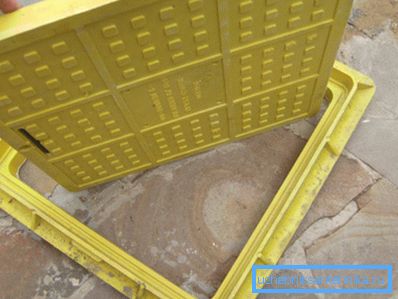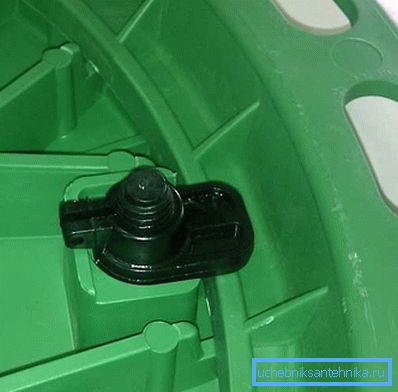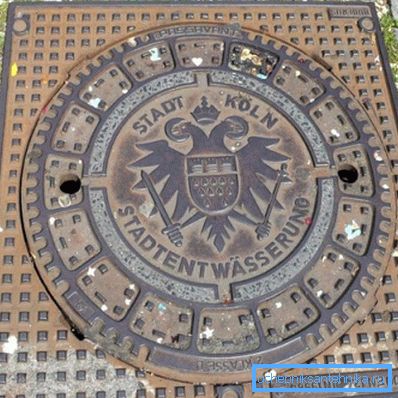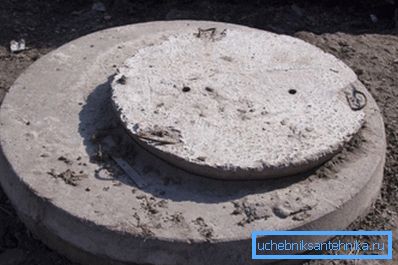Manhole: difficult moments of choosing a simple construction
The sewer, despite its apparent simplicity, should be chosen very carefully. The fact is that it performs a rather important function, at the same time providing access to the inspection or inspection well, and protecting the underground part of the sewer network from damage.
Below we will tell you what features of this detail you should pay attention first of all, and which product is better to choose when equipping the drainage system in different conditions.

Design features
Device
The manhole of the sewer well is a structure that is installed in the upper part of the viewing or inspection shaft.
As mentioned above, this part performs two functions:
- On the one hand, it prevents unauthorized access to the pipes.
- On the other hand, using the hatch, we ourselves can go down to the ground to perform diagnostics or repair.

The hatch device does not differ in complexity:
- In the well is fixed ring neck - stationary part.
- A cover is installed on top, which can be removable or hinged (hinged design).
- In some cases, two covers are mounted in the neck: a protective cover that fits on top, and a shut-off device equipped with a lock.
Note! Many wonder why sewers are round and not square. There are quite a few answers to this question, but the most plausible will be the following: a round lid, unlike a square one, will not be able to fall into the neck, as it is not turned.
So do not have to get from a depth of several meters heavy cast-iron "pancake".

- The outer surface of the lid is made flat or convex. The use of concave parts is irrational: they will collect rainwater.
Manhole locks
Usually, the connection of the neck with the lid is equipped with various locks.
Their main function is to prevent spontaneous opening, and - less often - to block the opening of the lid without a special key.
- The sewage cast-iron heavy manhole, which is familiar to us, as well as some models of polymer-sand composite, are completed with side projections that go into the slots on the neck.
- A plastic manhole can be made with a threaded connection of the lid and the well itself.

- Steel models are equipped with mechanical locks flag, bolt or spacer type. However, such structures are rarely used in water disposal systems: more often shut-off lids complete the shafts of communication lines, power lines, etc.
Functional classification

The weight of the manhole depends on two parameters: its dimensions and the type to which it belongs. To date, the most commonly used types of cast iron, and therefore in the table below we give exactly their characteristics:
| Marking | Product type | Weight, kg | Using | |
| cap | body | |||
| R | Repair | - | 35 | It is used to temporarily block the neck during road works. |
| L | Light | thirty | 35 | It is installed within green spaces, on footpaths, in private households. |
| T | Heavy | 50 | 50 | It is used when equipping manholes on the roads. |
| Tm | Heavy trunk | 45 | 50 | Mounted in the neck of wells located on highways with high traffic intensity. |
Note! In addition to the type, the marking of sewer manholes, which is applied to the products when they are released, should include the designation of the engineering network for which the part is intended, the year and month of production, etc.

The dimensions of the sewer cast-iron hatches according to GOST are also strictly fixed. Most often for the equipment of underground networks are used models with a diameter (on a cover) 645 or 800 mm. However, polymer and steel models may have other dimensions.
Popular varieties
Cast iron
If we have dealt with the main parameters and typology, let's dwell on the classification by materials in more detail.
The first place in popularity will be taken naturally by cast iron hatches:
- Both mouths and lids are injection molded.. For the manufacture of buildings take the material SCh15 and stronger, and the lid is cast from cast iron brand is not lower than SCh45.
Note! The design strength of the structure should exceed 60 tons.
- In some cases, the joint between the lid and the neck is additionally sealed with a rubber gasket.. To do this, use a thick rubber that can stay in a compressed state for a long time without losing elasticity.
- The service life of such structures is practically unlimited.. In Europe, you can find products that regularly perform their functions for more than a hundred years: externally, if they differ from new ones, they are only erased by faces.
- Minimal temperature deformations are characteristic of cast iron, therefore the road bed around the neck does not collapse..
As for the cons, they are:
- Due to the high mass, the installation of a manhole requires the involvement of assistants to work, and sometimes the use of additional devices.
- The price of the product is also very significant, which, however, is partially offset by the service life.
- But the main thing is that the manhole covers are systematically stolen, which makes it irrational to install them in unprotected areas.

Polymer
Recently, for installation on footpaths and in the zone of green plantings, instead of cast-iron manholes, structures made of plastic and composites are used:
- Polymer manhole sewer is usually made on the basis of quartz sand, cement and molten plastic. The mixture is heated to 3000C and placed in a special form under the press.
- To give the product a desired shade, green, brown or orange pigments are introduced into the composition of the raw material. This allows you to either make the hatch as inconspicuous as possible, or, conversely, draw attention to it in order to avoid injuries.
- The result is a fairly light (up to 45-50 kg) structure, which, depending on the internal structure, can withstand from 3 to 15 tons.

Note! In the most reliable hatches, a reinforcement cage made of steel rods or metal fiber is laid in the polymer.
- These parts are quite easy to assemble with their own hands, just open and close. In addition, their manhole covers are of no interest to "non-ferrous metal hunters", and the hull itself is highly anti-vandal-resistant.
- Among other advantages, it is possible to note a significant tightness, which is ensured by precise observance of dimensions during pressing, as well as the fact that in winter the lid does not freeze to the neck even at very low temperatures.
Well, the price of such products is incomparable with the cast-iron ones, so for the private construction recently they are mainly chosen.
Constructions from other materials
Along with cast and polymer models, other hatches can be found on sale:
- Plastic (most often polyvinyl chloride). Produced by injection molding, often supplied with composite or steel reinforcement. Due to the high elasticity, they do quite well with pedestrian loads, but in the cold they become very fragile.
Tip! The instruction recommends installing PVC hatches in suburban areas and in green areas, away from the routes of intensive movement.
- Concrete. Such parts are most often used as a temporary plug - during construction or in the theft of a metal hatch. They are discs made of reinforced concrete with one or two brackets used to move.

- The main disadvantages of concrete hatches are the almost complete lack of tightness (it is difficult to fit the lid tightly to the neck) and an unattractive appearance.
- Steel - it is easier pig-iron, but differ in smaller durability. Most often, they are supplied with locks and mounted in those places where it is necessary to block outsiders access to the sewers.
Conclusion
Polymer or cast iron manhole should be selected in accordance with the loads that he should experience. Then the drainage system will be reliably protected, and it will take very little time to replace the part (see also the article Domestic sewage pump: installation, features, advantages).
The video in this article will help you understand the nuances of the issue raised, so we recommend that you carefully study it.